Preschool Books About Who Is in My Family
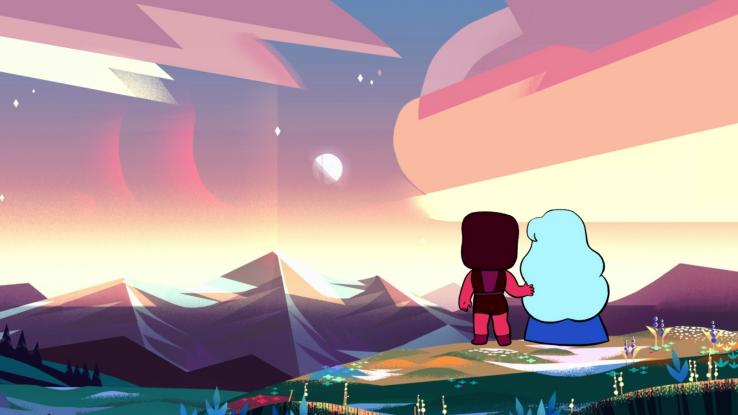
In 2019, Arthur, the long-running PBS series nearly an anthropomorphic, schoolhouse-aged aardvark, aired an episode called "Mr. Ratburn and the Special Someone." Colloquially, it became known equally the "Gay Rat Nuptials" episode, and it received a swell of support from queer fans, allies and organizations like GLAAD. Withal, even every bit recently as two years agone, that episode also faced immense backlash from homophobic detractors for portraying a queer wedding — for being inclusive.
Simply this wasn't the starting time fourth dimension the show depicted LGBTQ+ folks. Back in 2005, Arthur starting time faced backlash due to a spin-off episode, "Postcards From Buster." In it, Arthur'due south rabbit pal, Buster, visited actual (live-action) families — and one of those families happened to be a lesbian couple from Vermont. The public outcry was so huge that the then-U.S. Secretarial assistant of Didactics demanded PBS return the public funds it used to create the episode. And that was only 16 years ago.
"Until very recently, LGBTQ+ people would look to media and not have any representation or would only take a negative stereotype to place with," wrote Apr Sizemore-Barber, a professor in the women's and gender studies program at Georgetown Academy. "This absenteeism of stories leads to ignorance among members of the full general public [who don't run into LGBTQ+ stories represented] and isolation for those who identify as LGBTQ+ and are implicitly told that they don't exist."
In blitheness, for example, Disney has a long history of queer-coding its villains; even today, the studio reduces queer characters into blink-and-you-miss-it scenes, oftentimes played for laughs. So, yes, it's clear that a lot of work needs to be washed. And a lot of that work falls on the folks who are green-lighting shows and films.Arthur's one-off episode, for case, can help normalize queer families, but shows similarSteven Universe andKipo and the Historic period of Wonderbeasts are moving the punch even further on a more than regular basis.
So, what can we do as audiences to support queer and trans creators and their LGBTQ+-inclusive narratives? Nosotros can watch them — all year round. And so, whether you're looking to celebrate Pride Calendar month, diversify your kids' media intake year-round, or find positive representation for queer and trans kids who want to come across themselves reflected in queer characters and stories, check out these must-sentinel Boob tube shows and films that center queerness.
Animated Goggle box Series
Steven Universe
Created by Rebecca Sugar for Cartoon Network, Steven Universe tells the coming-of-age story of the titular boy (Zach Callison). Although Steven's dad is a car launder-owning rock musician, his mom, Rose Quartz, was a gem — a magical, humanoid alien from outer infinite. Years ago, Rose led the Crystal Gems, a rebel grouping, in a war to protect Earth from her alien Homeworld, which sought to colonize World and strip it of its resources. When she gives birth to Steven, Rose passes on her powers and life-strength, leaving the other members of the Crystal Gems — Garnet (Estelle), Amethyst (Michaela Dietz) and Pearl (Deedee Magno Hall) — to raise Steven and protect Earth in Rose'due south stead.
This decidedly queer Peabody Award-winning show is frequently hilarious and fun, but it also speaks to the importance of chosen family unit and how to form healthy interpersonal relationships. While at that place's a lot of smashing LGBTQ+ representation, information technology'due south worth pointing out a few characters in particular. In order to become stronger, Steven Universe's Precious stone characters can fuse together when needed. But Steven, our one-half-Gem and half-homo protagonist, has the uncanny ability to fuse with his man friend, Connie Maheswaran (Grace Rolek). Together, the duo make up Stevonnie. In addition to using gender-neutral pronouns, Stevonnie shared in a Cartoon Network PSA that they are non-binary and intersex.
Other history-making characters include Ruby and Sapphire, the two Gems who fuse to make Estelle'due south Garnet. However, instead of fusing temporarily, Ruby and Sapphire remain Garnet (almost always) as an expression of their dearest. Sugar, the creator and showrunner, has said that the "Gems are all nonbinary women… They're coded female… They wouldn't think of themselves as women, but they're fine with being interpreted that way amongst humans." In a 2018 episode, Ruby asks Sapphire to marry her, marking the first aforementioned-sex activity proposal in mainstream children's TV — which, of course, was followed past a groundbreaking wedding episode.
Blueish'south Clues
To celebrate the starting time of Pride Calendar month, Nickelodeon's long-running Blueish's Clues hosted an incredibly intersectional virtual Pride parade. Drag Race contestant Nina Westward hosted the parade — in cartoon course, of grade — by singing a tune that celebrated the various families in attendance. "When a cartoon elevate queen leads me on a three-minute journey through the magic of embracing the queer family in all of its multifaceted glory, who am I to say no?" writes BuzzFeed'due south Mary Colussi — and we couldn't concord more. Without a doubt, Nick Jr.'southward landmark parade is a slap-up style to introduce youngsters to various LGBTQ+ identities and families.
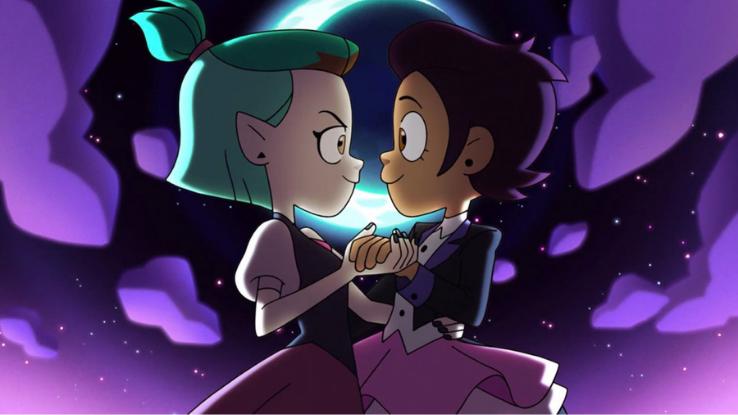
The Owl Firm
Information technology'southward no secret that Disney'south big-screen representation has been sorely defective. In addition to queerbaiting fans, Disney has used the promise of on-screen representation to garner buzz for their films, and, in the cease, that buzz amounts to aught much. In the alive-action remake of Beauty and the Animate being (2017), queerness was played for laughs. Two years later, in Avengers: Endgame (2019), an unnamed, inconsequential human mentions going on a date with another man. And, that same year, in Star Wars: Episode 9 – The Rising of Skywalker, 2 women share a truly glimmer-and-you-miss-it celebratory kiss; in that aforementioned scene, even a Resistance member embracing a infinite slug gets more onscreen visibility.
While nosotros wish the visitor was as enthusiastic virtually queer protagonists as Raya and the Last Dragon star Kelly Marie Tran, at that place's some hope in the form of Disney Channel'due south The Owl Business firm. Disney'southward first queer blithe pb appearing on TV instead of in a theatrical release isn't surprising; although the evidence has been banned in several countries due to its LGBTQ+ representation, its success doesn't hinge on box office draw.
Regardless of the corporation's messy track record, we love The Owl House. The testify centers on Luz Noceda, a man teenager who stumbles through a portal to another (more magical) globe and becomes a witch'due south amateur. Since its debut, the GLAAD Media Laurels-nominated show has received praise for featuring several LGBTQ+ characters — and for depicting a romance betwixt Luz, who creator Dana Terrace has confirmed is bisexual, and the prodigious young witch and lesbian Amity Bane.
She-Ra and the Princesses of Power
Created by Eisner Honor-winning comic writer/artist Noelle Stevenson (Nimona, Lumberjanes), She-Ra and the Princesses of Power is a reboot of the 1985 serial She-Ra: Princess of Power — a spinoff of He-Human being and the Masters of the Universe. The serial' protagonist is Adora, a teenager who trained alongside her then-friend Catra in the Lord Hordak's (evil) Horde army.
In the pilot, Adora gains the power to turn herself into the show's titular heroine and, together with a group of other magical princesses, vows to defeat Hordak. The testify is total of queer characters, including a nonbinary, shapeshifting character named Double Problem (Jacob Tobia) and Spinerella and Netossa, two queer women in a same-sexual practice relationship. Additionally, the Emmy- and GLAAD Media Award-nominated show has been praised for taking on hard topics, such as the circuitous best friend-turned-archenemy relationship between Adora and Catra, which — spoiler warning! — culminates in a very articulate, and very queer, declaration of dearest in the prove's recent final flavour. With a diverse bandage and a great mix of action, sense of humor and feels, She-Ra is an epic romp you won't want to miss.
Kipo and the Historic period of Wonderbeasts
Kipo and the Age of Wonderbeasts is Netflix'southward under-the-radar gem you should be watching — for many reasons. One of those reasons? Information technology treats coming out similar whatsoever other part of life. It isn't the source of drama or tension; instead, it'southward a sweet moment shared between friends. Created past Radford Sechrist, the show tells the story of Kipo Oak, who traverses a mail-apocalyptic country in search of her begetter. On her journey, she befriends both man and mutant animal pals.
When Kipo tells Benson, ane of her human friends, that she likes him, he shares that he likes her every bit a friend because he's gay — and he actually says the words, "I'1000 gay." Writing for Polygon, Petrana Radulovic notes that the scene is "a showtime for all-ages animation," considering even on shows like She-Ra or Steven Universe, characters don't declare their queerness. "I could argue that it's a matter of showing and not telling," Radulovic points out, referring to the way queer characters on other shows just are, no declarations needed. "…but there's a different effect to a character proclaiming 'I'1000 gay,' allow lonely a pb character." The series as well features Asher, a non-binary character, and Troy, a gay character who's crushing on Benson only as much every bit Benson'south crushing on him.
Young Justice
Rounding out our picks is DC Comics' Young Justice, which features Halo. A fusion of Gabrielle Daou, a deceased Quraci girl, and the spirit of a Motherbox, or "living reckoner," Halo joins Nightwing'due south squad of heroes. Halo doesn't view themself as Gabrielle anymore, instead going by the pseudonym Violet Harper, and, while they don't explicitly use the term "non-binary" at first, they do announce that they don't know if they are a male child or a girl when misgendered by a teammate.
Although shows similar Young Justice and Arthur aren't as lauded for their representation as some of the other entries on our listing, these storylines and characters do reflect changing norms, not just in children's programming, but in society at large — and that's incredibly meaningful.
Feature-Length Films
Gamble Time: Afar Lands — Obsidian (2020)
For years, Adventure Time's Princess Bubblegum (Hynden Walch) and Marceline the Vampire Queen (Olivia Olson) had some subtextual romance brewing. In fact, it was strongly implied both in the prove and in spin-off comics that the two were exes. After endless adventures, a lot of very sweetness sentiments, and ten long seasons, the duo finally cemented their romance onscreen with a kiss in the serial' finale.
More recently, the couple starred in "Obsidian," a feature that'south 1 of HBO Max'due south four Adventure Fourth dimension: Afar Lands specials. In improver to filling in the gaps in the couple'southward long history, "Obsidian" packs an emotional punch and serves up some great new tunes. Best of all, information technology turns all that subtext we'd poured over for years into indisputable canon. Writing for The A.Five. Club, William Hughes calls it "fan service at its finest."
The Half of It (2020)
Saving Face (2004) marked Alice Wu'due south directorial debut and, honestly, a filmmaker couldn't ask for a better first outing. Now, over a decade later, Wu released her sophomore feature, The Half of It, on Netflix to slap-up acclamation. Pitched as a "different kind of honey story," The Half of It is a loose retelling of the Cyrano de Bergerac story — with a queer twist. Or what Rolling Stone describes every bit a "quietly revolutionary accomplishment…brimming over with pleasures of the unexpected."
Ellie Chu (Leah Lewis) lives in the small town of Squahamish, and she spends her time writing papers for her peers in exchange for money and handling her dad's station main and signalman duties at the boondocks'due south railroad train cease. When she meets Paul Munsky (Daniel Diemer), a well-significant just inarticulate jock, Ellie writes letters on Paul'southward behalf to Aster Flores (Alexxis Lemire), his crush — and, as it turns out, Ellie'southward crush, also. While it was marketed (in role) as a YA rom-com, the picture is more than longing than first romances, but it still feels refreshing. After all, every bit Lewis points out, "[i]t's a self-love story… [the characters] end upward with something… It is a dear story, it's just not a 'romance' story."
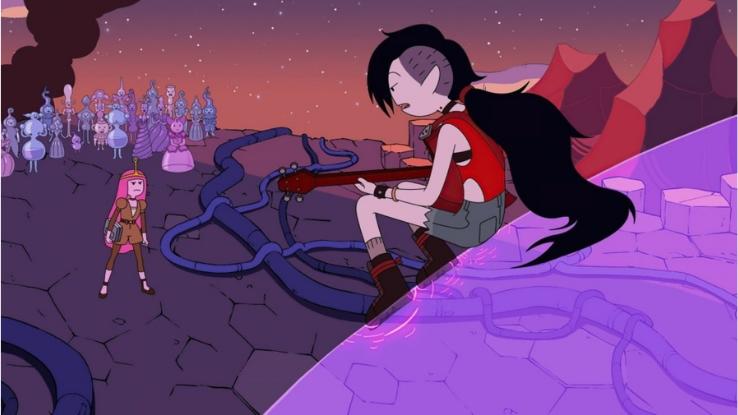
The Mitchells vs. the Machines (2021)
Released in select theaters and on Netflix in Apr 2021, The Mitchells vs. the Machines has been warmly received by critics and audiences akin — and deservedly so. The film centers on Katie Mitchell (Broad City's Abbi Jacobson), an artsy, outsider teen with a talent for making short films. Later feeling "weird" her whole life, Katie can't wait to head to college in California; fifty-fifty her grouping chat with her soon-to-be filmmaker classmates is labeled "My People."
The only problem? Katie'south outdoorsy dad, Rick (Danny McBride), doesn't quite go her — nor does he understand Katie's films or the fashion she finds customs through technology. After a father-daughter fight on Katie's last night home, Rick decides to abolish Katie's flight and take the family unit on one terminal road trip. Simply, equally fate would have information technology, Mark (Eric André), the founder of the tech company PAL, a kind of Amazon/Apple combo, accidentally triggers the robot apocalypse. This leaves the dysfunctional Mitchell family — which is rounded out by Katie's mom, Linda (Maya Rudolph); Katie's dinosaur-loving brother, Aaron (Michael Rianda); and the family dog Monchi (Doug the Pug) — to relieve the globe.
The Mitchells vs. the Machines is also visually stunning: each frame is packed with so much item and takes inspiration from Katie's journaling and cobbled-together short film aesthetic, giving information technology a personal (and appropriately frenetic) experience. All-time of all, the team behind the pic have worked on standout animated fare, like Gravity Falls and Spider-Human: Into the Spider-Verse (2018), and then you know there will be a lot of heart and some sharp humor. Plus, Katie is queer — and, by the end of the motion-picture show, has a potential girlfriend — just, thankfully, none of the drama or heartache revolves around her coming out or identity.
Coming Before long to Netflix:The Witch Boy (TBA, 2021)
Based on Molly Knox Ostertag's graphic novel series of the aforementioned name, The Witch Boy is gear up to be a landmark animated musical. The story follows Aster, a young boy who discovers he's a witch — even though, in his globe, only girls inherit witchy powers, while boys are meant to exist shapeshifters. To protect his surreptitious, magical community and learn more about himself, Aster sets off on a journey of discovery.
Directed by Minkyu Lee (Adam and Domestic dog, Love Basketball game, Large Hero 6) and featuring original music from Grammy-nominated ring HAIM (composed of sisters Este, Danielle, and Alana Haim), The Witch Boy is shaping up to exist one of the most hotly anticipated (and original) animated films of the year. "My hope is that this film, by celebrating queerness and otherness,' will come up to audiences around the world equally something truly special," Lee said.
Books for Younger Readers
The Boy & the Bindi by Vivek Shraya with Illustrations by Rajni Perera
Canadian musician, writer, visual artist and Tegan and Sara Foundation board member Vivek Shraya's first book, God Loves Pilus, was nominated for a Lambda Literary Award in the YA category. Centered around the life of a brown, genderqueer kid growing up in an immigrant family in Alberta, the book is composed of illustrated, linked stories. Several years later, The Boy & the Bindi marks Shraya's get-go foray into writing a children'south picture book.
Illustrated by Rajni Perera, the book is well-nigh a young male child's obsession with his mother'southward bindi — "a colored dot worn on the center of the forehead," originally by folks from India who practice Hinduism and Jainism — and his desire to vesture a bindi, also. The School Library Periodical praised the book, noting, "With gentle rhymes and warm whimsy, amplified by Toronto artist Perera's richly hued illustrations… [Shraya], a transgender woman, deftly explores difference and self-acceptance, the subversion of gender expectations, and the ability of 'making sure I don't hide/Everything I am inside.'"
The Frog and Toad Books by Arnold Lobel
While these sweet stories virtually two tweed-wearing amphibians aren't explicitly queer, and while we'd normally champion works that go beyond subtext, in that location's something special near Arnold Lobel's Frog and Toad books. Published betwixt 1970 and 1979, the stories were written amidst Lobel's own personal revelation. "I think Frog and Toad really was the beginning of him coming out," Adrianne Lobel, the author's daughter, told The New Yorker.
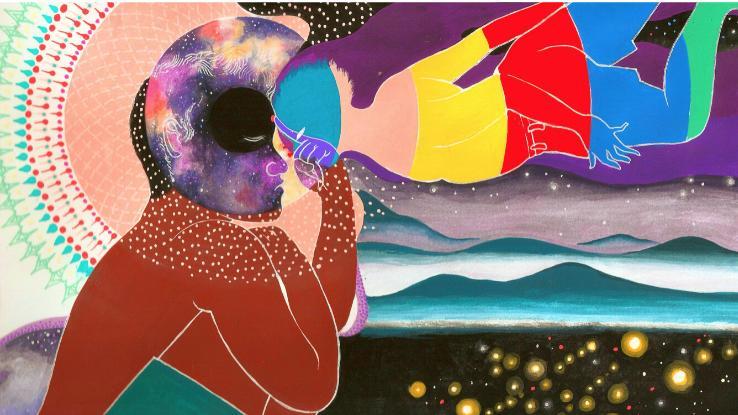
If Frog and Toad had been written virtually in a different fourth dimension, their queerness probably would've been more subtext, but information technology nevertheless resonates deeply. In fact, there's really no heterosexual explanation for their dynamic. "What my partner and I take found, though, is that in the pages of Lobel's queer love story, at that place is a pattern for how to live and thrive every bit a queer couple," S.E. Fleenor writes in an essay for Electric Literature. "The honey characters are expert part models for children in any number of ways, demonstrating positive ways of coping with feet, frustration, and boredom… I've besides realized that they're the model of a queer relationship I always needed."
Mythology-Based Books From the "Riordanverse"
Rick Riordan is best known for his chart-topping YA novel Percy Jackson and the Olympians, which tells the story of a young male child who discovers he'due south a demi-god — and then finds himself caught upwardly in mod-day Greek mythology-inspired misadventures. After writing many a novel inspired past Greek mythology, Riordan pivoted to Norse mythology, which brings u.s. to Magnus Chase 2: The Hammer of Thor, which won a Stonewall Award for queer representation.
Later on receiving the Stonewall, Riordan said in his acceptance speech, "So, what is an old cis straight white male doing upwardly here? Where did I get the nerve to write Alex Fierro, a transgender, gender fluid child of Loki in The Hammer of Thor, and why should I get cookies for that? These are all off-white and valid questions, which I have been asking myself a lot." Riordan went on to say because his queer readers want to exist part of the universe he's created, he felt responsible for creating some mainstream representation. "Every bit important as it is to offer authentic voices and empower authors and role models from within LGBTQ customs, it's also important that LGBTQ kids see themselves reflected and valued in the larger earth of mass media. …I will not erase y'all."
Long story short, check out Riordan's queer-inclusive fantasy novels. And check out his Rick Riordan Presents imprint, which leverages his platform to give more visibility to #OwnVoices Percy Jackson-esque works about other cultures and mythologies — by authors with those actual, lived experiences.
Stories for Young Adult (YA) Readers
Laura Dean Keeps Breaking Up With Me by Mariko Tamaki with Illustrations by Rosemary Valero-O'Connell
Later on working on projects similar Marvel'due south She-Hulk, DC Comics' Supergirl and Noelle Stevenson'southward queer comic Lumberjanes, writer Mariko Tamaki collaborated with artist Rosemary Valero-O'Connell for the hitting graphic novel Laura Dean Keeps Breaking Up with Me. Set in Berkeley, California, the book centers on Frederica, or Freddy, a 17-yr-old biracial lesbian, and, every bit the championship of the graphic novel suggests, she struggles with her on-again/off-again relationship with "absurd girl" Laura Dean.
At first, the premise might seem like quirky rom-com fodder, but it becomes a very real examination of a toxic relationship: Laura constantly gaslights Freddy, manipulates her, and fetishizes their relationship. At its cadre, Laura Dean is a story about finding i's own self-worth and identity — of not letting others (or others' actions) ascertain you, which isn't something a lot of YA media tackles in such a head-on style. Additionally, Forbes writer Rob Salkowitz wrote that Laura Dean'southward inclusion of a "depoliticized and unfussy depiction of gender-fluid teen culture in the 2010s" makes the graphic novel "a pace forward in LGBTQ graphic literature."
You Should See Me in a Crown by Leah Johnson
Author Leah Johnson has written an incredible debut novel — one that the publisher describes as "a smart, hilarious, Black daughter magic, ain voices rom-com by a staggeringly talented new writer." Chances are, if you haven't read You Should See Me in a Crown, you lot've at to the lowest degree seen other people reading this bonafide striking (and presently-to-be archetype).
In the novel, Liz Lighty, who has "always believed she'southward too Black, too poor, too bad-mannered to shine in her small, rich, prom-obsessed Midwestern boondocks," dreams of getting abroad by fashion of an elite college with a world-famous orchestra — well, until her financial aid falls through. After realizing in that location'southward a scholarship available for prom queen and king, Liz has to endure the competition — and alluring new girl Mack — as she navigates high schoolhouse, relationships and settling into her own queerness and queer joy.
Felix Ever After by Kacen Callender
In Felix Ever Subsequently, Stonewall and Lambda Award-winning author Kacen Callender crafts a landmark YA novel about Felix, a transgender teen who fears that he's "one marginalization too many — Black, queer, and transgender — to ever get his ain happily ever-later." When a transphobic student publicly posts Felix's deadname and photos on campus, our protagonist plots his revenge — and, throughout the course of the novel, navigates both self-discovery and a blossoming, unexpected first beloved.
Intricately plotted and beautifully written, Felix Ever After is an essential read. In a starred review, Booklist notes that "[f]rom its stunning encompass art to the rich, messy, nuanced narrative at its heart, this is an unforgettable story of friendship, heartbreak, forgiveness, and self-discovery, crafted by an writer whose obvious respect for teen readers radiates from every folio."
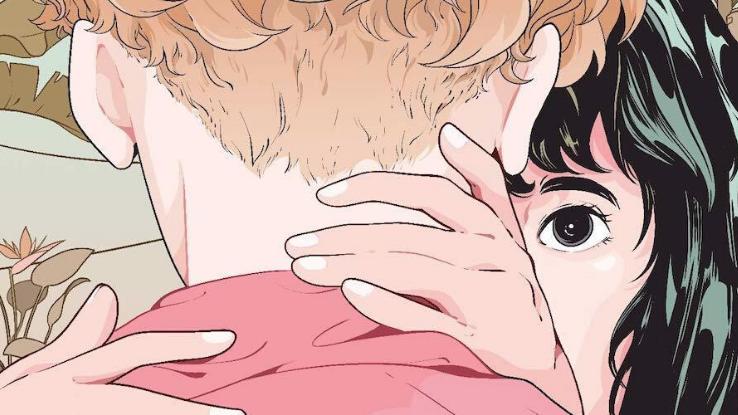
Cemetery Boys by Aiden Thomas
In this debut paranormal novel, Yadriel, a young trans boy, is determined to show himself, and his gender, to his traditional Latinx family. This leads Yadriel to perform a ritual — ane he hopes volition help him observe the ghost of his murdered cousin. But things don't e'er go as planned, specially when you lot're dealing with the supernatural. The ghost Yadriel really summons is Julian Diaz, the resident bad boy who has some loose ends to tie up before he passes on. And the longer the 2 boys piece of work together, the more than Yadriel wants Julian to stay.
Early on, Entertainment Weekly dubbed Cemetery Boys "groundbreaking" — and that couldn't exist more than truthful. "It was […] really of import for me to write a book where LGBTQIA and Latinx kids could see themselves being powerful heroes," author Aiden Thomas said in an interview. "Right now, these kids are living in a globe where a lot of hate and suffering is zeroed in on them. I wanted them to see themselves being supported and loved for who they are. I wanted to write a fun book with expert representation that they could escape into and have a happy ending."
All Boys Aren't Blueish: A Memoir-Manifesto by George G. Johnson
With what School Library Periodical calls "a conversational tone [that] will go out readers feeling like they are sitting with an insightful friend,"All Boys Aren't Bluish explores topics like gender identity, toxic masculinity, and Black joy. Penned past journalist and LGBTQIA+ activist George G. Johnson, these personal essays are, in part, so landmark — and so meaningful to queer Black readers in detail — because we don't often see memoirs written specifically for young adults.
This tin can't-miss memoir-manifesto is also beautifully written — total of lovely language and untold amounts of guidance and support. "This title opens new doors," Kirkus Reviews notes. "[…T]he author insists that nosotros don't take to anchor stories… to tragic ends: 'Many of the states are still here. Still living and waiting for our stories to be told―to tell them ourselves.'"
Universes That Encompass Books, Telly & Moving-picture show
The Legend of Korra — and Other Avatar: The Last Airbender Spin-Offs
The Legend of Korra is the sequel serial to Nickelodeon's beloved Avatar: The Concluding Airbender series. The original show tells the story of Aang — a young male child who tin can curve (or control) the iv elements of fire, h2o, air and globe, because he is the Avatar, a being that's the bridge between the human and spirit worlds and who is destined to bring about balance. Aang is tasked with mastering the elements and saving the globe from a century-long war that'due south coming to a head. In the sequel series, Korra, who is built-in the Avatar after Aang passes away, is tasked with carrying on that legacy and mastering the elements.
Like Aang, Korra gets by with a lilliputian help from her friends — namely Bolin, Mako and Asami. In the show's first season, Korra crushes hard on Mako, but he and Asami end upwardly existence an item — well, until the finale, when he and Korra finally become together. While Korra and Mako don't last more than than a half season, the Avatar does end up finding truthful love.
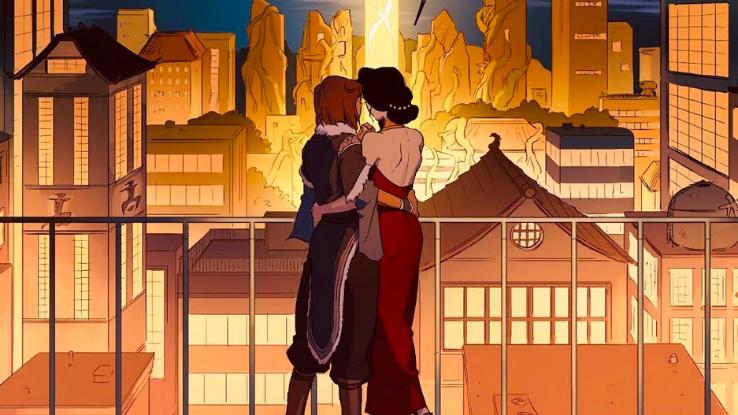
At the time, Korra's series finale was a landmark moment for children's television receiver — and tv in general. In the third and fourth seasons in particular, at that place seems to be a growing romantic tension betwixt Korra and Asami — though fans, used to beingness allow down past queer rep in cartoons in full general, felt the subtext wouldn't go beyond that. But, in the last few moments of the show, the pair clasp hands and embark on a new journeying together — just the two of them. They almost buss, but don't; Nickelodeon wasn't ready for that. Luckily, subsequent comic series, Turf Wars and Ruins of the Empire, have gone on to flesh out the pair's romantic human relationship.
Avatar fans should also check out the Avatar Kyoshi novels; written by F. C. Yee,The Rise of Kyoshi and The Shadow of Kyoshi trace the adventures of the Earth Kingdom-born titular Avatar — and, as we've known since the first Korra graphic novel, Kyoshi is also queer. "Folks who know what the canon is from Korra are going to exist looking for [Kyoshi's queerness to be represented in the books], and other readers might exist learning for the first time that a Kyoshi is bisexual in this novel," Yee told Polygon. "It felt really of import for me to include that and essentially do her relationships justice."
Becky Albertalli's "Simonverse"
Becky Albertalli's 2015 immature developed (YA) novel Simon vs. the Homo Sapiens Agenda skyrocketed to success, cementing the author's place every bit a honey YA writer — so much so that her other books, The Upside of Unrequited, Leah on the Offbeat and the forthcoming Love, Creekwood, have added fifty-fifty more than dimension to what's been dubbed the "Simonverse." All of Albertalli's books really capture teen voices and stories — many of them queer — simply in that location's something and so winning well-nigh Simon in detail.
In the novel, Simon'due south a closeted gay teen who is relieved — and broken-hearted and excited — to discover that at least one other classmate, who posts anonymously on a message lath, is queer and not yet set to come out. Under a fake name, Simon embarks on a secret email friendship with the other teen, known only as Blue — before finding himself blackmailed by swain high schooler Martin when he forgets to log out of his e-mail. When Simon is eventually outed, he has to navigate both positive and negative reactions from his friends and family unit, and, eager to meet Bluish in existent life, takes a large chance on honey.
In 2018, Albertalli'south book was adapted into the sweet rom-com, Love, Simon, which, although a little sanitized and glossy, gives queer kids (and adults) a mainstream gay teen movie. (Hopefully, the first of many!) And, just terminal year, Dearest, Victor, a spin-off of the movie, launched as a series on Hulu. The well-received series centers on Victor Salazar (Michael Cimino), a queer teen on his ain journey of self-discovery and acceptance, who, to fans' excitement, reaches out to Simon (Nick Robinson reprises his role) when things get hard.
Curiosity'south Runaways
Marvel's Runaways, a Hulu serial based on the superhero team of the same name, follows six teenagers (and one dinosaur) from unlike backgrounds as they unite against a common enemy — their criminal parents, who are collectively known equally Pride. 2 of these teens are Nico (Lyrica Okano) — a Wiccan who wields the arcane Staff of Ane — and Karolina (Virginia Gardner) — a human-alien hybrid who learns she can fly and shoot beams of low-cal from her hands. Y'all know, typical teen stuff.
What's unique near this story? Information technology isn't focused on the teens' coming-out process. Near right from the jump, the audience learns that Karolina has a vanquish on her friend Nico. Merely she'south not afraid of making a move because of who she is — she's but afraid of beingness rejected by her crush. When Karolina does confess her feelings to Nico, the ii share a kiss, which marks an onscreen start for Marvel's queer superheroes.
Source: https://www.ask.com/entertainment/childrens-media-movies-tv-shows-books-family-lgbtq-pride?utm_content=params%3Ao%3D740004%26ad%3DdirN%26qo%3DserpIndex
0 Response to "Preschool Books About Who Is in My Family"
Post a Comment